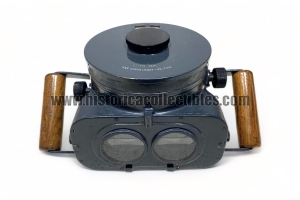Coincidence Rangefinder Binoculars 15x46, Vickers-Armstrongs Ltd., circa 1930
Image coincidence rangefinding binoculars, produced by Vickers-Armstrongs Ltd., most likely for the Argentine Navy, in around 1930.
This is the first image coincidence binoculars ever produced, i.e. a mechanical manual computer for all the calculations necessary for shooting against the enemy, such as: Distance, Length and Inclination. In fact, in the upper part of the binoculars there are the words "Eslora Enemigo en Metros" (Length of the Enemy in Meters) by manually rotating only the upper disc you select the known length of the enemy "vehicle", from 30 to 250 meters, and then move on to infinity (∞) and respectively the degrees of inclination.
By rotating the two knobs located on the side, the internal optical/mechanical group is moved to match the image and therefore it is possible to have a correct reading, in the front panel of the binoculars, of the relative meters of distance from the enemy, which range from 3500 to 28000 meters, and then goes to infinity (∞). Just below them there are two caps, with the graduated rotation mechanism inside, which is used for zeroing adjustment (a bit like the levelling rod for the rangefinder).
Focusing occurs by rotating the knurled rings placed on the eyepiece bases, by means of a complicated mechanism made up of 10 parts, which allows the eyepiece to come out without any rotation of the eyepiece. This was necessary for reading the information (Metros Distancia - Grados Inclinación), by means of the prism placed on the left eyepiece, without having to take your eyes off the view (a real innovation for that era), furthermore this mechanism is found only on this binoculars.
With the knurled knob located in the lower part, the interpupillary distance is adjusted, thus moving both optical groups, via an infinite screw mechanism.
Instruments of this kind were installed in coastal bunkers and on the decks of ships, alongside other instruments for the various measurements useful for shooting.
Comfortable viewing, perfectly collimated, with its rubber eyepieces and handles to lean on for directional adjustment.
Vickers-Armstrongs Limited was a British engineering conglomerate formed by the merger of the assets of Vickers Limited and Sir W G Armstrong Whitworth & Company in 1927.
In December 1926 the not prosperous situation of Armstrong Whitworth pushed the creditor banks to advocate a merger of the armaments and steel activities with those of Vickers, in order to create a single company that could self-sustain in the unfavorable situation which saw the progressive reduction of military orders. In 1927, Vickers-Armstrongs, Ltd was founded with Vickers holding two thirds of the new company and Armstrong Whitworth forced to sell its shares in exchange for the extinction of the debt it had with the banks. Both parent companies were active in various arms sectors with similar production lines covering the design and construction of ships, locomotives, automobiles and aircraft. Armstrong Whitworth was renowned for its artillery factory based at Elswick, in the borough of Newcastle upon Tyne, and its shipyard at High Walker on the River Tyne.
In 1929 the railway branch of Cammell Laird was also acquired to establish Metropolitan Cammell Carriage and Wagon (MCCW) in Birmingham.
At the beginning of the 1930s the Company employed between 15,000 and 24,000 people, 80 percent of whom were engaged in the production of armaments.


